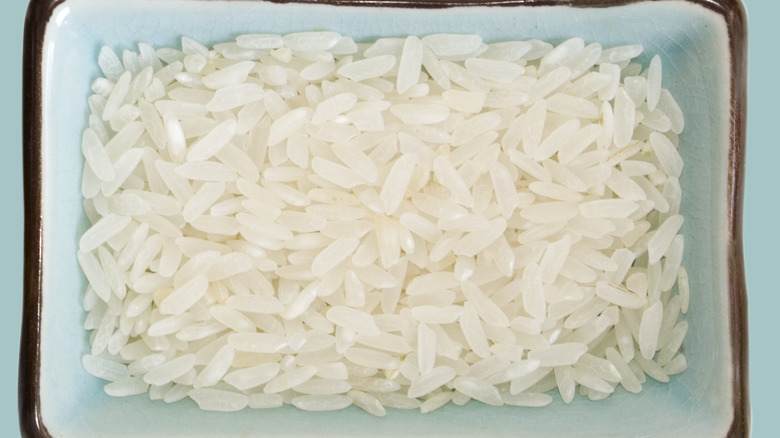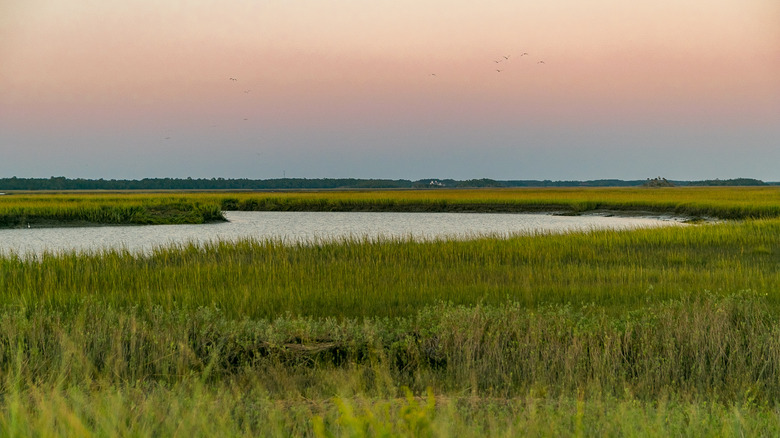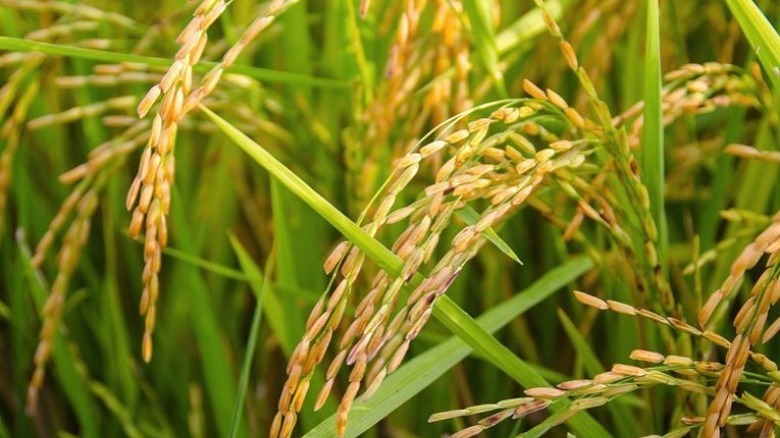The Fascinating History Of Carolina Gold Rice
We might be spoiled for choice when it comes to rice options these days between short-grain Koshihikari for sushi, creamy Carnaroli for risottos, Indian Basmati for Biryanis, and U.S. Jasmine as a go-to for everything from salads to sides. But before all of this, there was the flavorful Carolina Gold — a rice varietal so popular it was once considered to be "the world's greatest rice," per Taste Atlas.
Carolina Gold may be considered a specialty rice today, but as Serious Eats points out, that wasn't always the case. For a good part of early American history, it was the country's dominant rice, which first took root when a local planter who lived in the South Carolina settlement first known as Charles Towne (which is modern-day Charleston) was paid in grains from Madagascar by the captain of a shipping vessel whose ship was repaired after a storm.
The rice, which came to be known as Carolina Gold, was a natural fit because the region's soils were not only fertile and mushy, but it was also fed with fresh river water that flooded the plains. So just 15 years after the grains were first brought to the area, Carolina Gold became a major crop, making Charleston the richest area in the British colonies per capita when America declared its independence, per The Post and Courier.
The production of Carolina Gold was deeply intertwined with the practice of slavery
But while Carolina Gold might have been the first commercial rice produced in the United States, it's cultivation was not so glorious. Serious Eats reports that there was high demand for expertise in growing the grain, and the best place to find that was in western Africa, which was also known as the Rice Coast. Because of this there was a strong appetite to enslave people from the "Gold Coast or Gambias," per The Post and Courier, which also stated that most enslaved to work on the plantations survived only a few years in part because of the harsh living and working conditions.
Industrialization helped the Carolinas export 60 million pounds of rice during that time. An inventor named Jonathan Lucas helped make that happen by creating mills that used big stones to remove rice hulls. These mills were powered by a system of buckets and fans which were eventually widely used across the Carolina South Carolina Lowcountry, per The Post and Courier. Historian Richard Porcher notes that Lucas' milling machine was as critical to rice as Eli Whitney's gin was to cotton. The industrial production of Carolina Gold was so intertwined with slavery in the region that it is no surprise that the enterprise collapsed when those enslaved across the South were emancipated following the Civil War.
Carolina Gold was revived in the late 1980s
Aside from the end of slavery, The New York Times reports several reasons for the near-abrupt disappearance of Carolina Gold. Rice fields also bore the brunt of hurricanes that continue to sweep through the area to this day. The disappearance is also attributed to silt from cotton farms that were located further upstream. Then there is the region's topography: The soft soil and marshy fields perfect for growing Carolina Gold was not strong enough to support the industrial machinery now needed to grow and harvest rice. It was in 1927 when Carolina Gold was harvested commercially for the last time.
Still, as author David Shields writes in "Southern Provisions: The Creation and Revival of a Cuisine" (via Serious Eats): "Because it was such a legendary rice, and because it had been central to the cuisine of the southern Atlantic coast, it never evaporated from cultural memory. Writers' rhapsodies over the taste of 'wild-rice-fed' ducks in old Carolina, the family cookbooks filled with pilaus, purloos, chicken bogs, and other dishes that specified 'Carolina Rice,' made residents wonder what had gone missing."
The New York Times states that it is thanks to the efforts of Georgia optometrist Richard Schulze, who first obtained a seed from the United States Department of Agriculture's (USDA) Rice Institute in Texas to grow something to feed ducks with, that Carolina Gold emerged from the shadows to become the specialty rice that it is today.


